_____A.M.Williamson's class blog for Harris's MCS143F._____ >The gaze of the camera represents a “Hailing” in the Althusserian usage. Certain queer films Hail the audience with a gaze Other than the Male Gaze, deterritorialize them of that objectifying and consumptive gaze, and interpellate them as liminal subjects past the imaginability of heteronormative ideology.
Don't wanna be here? Send us removal request.
Video
In case you missed it, here’s the moment when three trans women, played by three out trans actresses, casually chatting over lunch, appeared on a prime-time drama on the single biggest television network in the U.S.
Doubt (CBS) was revolutionary in having a trans lead, played by Laverne Cox, but they also had a trans woman in the writer’s room (Imogen Binnie), and trans actors, like myself and Angelica Ross in the scene above, and Alexandra Grey in the following episode (who gives a devastating and powerful must-see performance).
This level of attentiveness was largely due to the creators/showrunners, Joan Rater & Tony Phelan, having a trans son, the actor Tom Phelan. For Joan & Tony, trans people weren’t “other”, they weren’t punchlines, they didn’t exist just as metaphors, or props to trigger male anxieties. They’re real people, whole and complicated people with rich lives that can’t be reduced to the single facet “trans”.
Three friends having lunch and talking over boy trouble, in public, in daylight. This is how we come out of the shadows.
RIP Doubt; long live the team behind it.
53K notes
·
View notes
Text
ENTRY - FINAL. First, a Conclusion; Second: the Queer Possibility of Netflix’s Altered Carbon, if only they’ll do something with it
This blog has considered the possibilities of a cinema apparatus that does not exclusively traffic in the cis-Male Gaze. To that end, it has looked at some more radical works, that profile characters that the Male Gaze does not succeed in objectifying -- Ma Vie en Rose, Venus Boyz -- and it has considered films with, if not a cis-Male Gaze, at least a queered Male Gaze, such as Beau Travail, Hannibal, and La Ley del Deseo.
It has also examined films, that, to greater or lesser levels of success, have exhibited a Male Gaze that then it has troubled and problematized, perhaps even fully subverted. La Ley del Deseo did this to shocking effect. Hannibal makes it a series long project to interrogate the hungry Gaze. M. Butterfly made an orthodox monster out of the Gaze, by contrast to the transformed protagonist, who in the film’s final moments, exceeds it.
These works subvert the Male Gaze. Works that rely on it not at all are rare perhaps, but unlike Mulvey asserts, I would argue, not only possible, but already out there. At the very least, subversive “non-narrative” (at least, not conventional or linear.) films like Water and Power (Pat O’Neill, 1989) employ a Gaze that is.... perhaps not only not “Male” per-say, but perhaps not even “concious” -- dreamlike, fractured, de-territorializing, and certainly subversive of power in many forms, imperial, narrative, Male.
youtube
Water and Power (1989) by Pat O’Neill.
But to end this blog, I am going to go more the direction of Gilda -- back to noir, back to something much more conventional and rigid and essentialist and “Male Gazey.” I am doing this for a particular reason -- as in real life, this final Text I am going to look at leaves a margin with Queer possibility. I think it leaves a WONDERFUL margin for Queer possibility -- so wonderful that I wonder if Netflix isn’t going to try to own the traffic in Queer gaze outright, make an Empire out of it like Disney has been expanding the Empire of Star Wars in the last few years.
Let’s talk about “Altered Carbon.”
***************************************************************************************
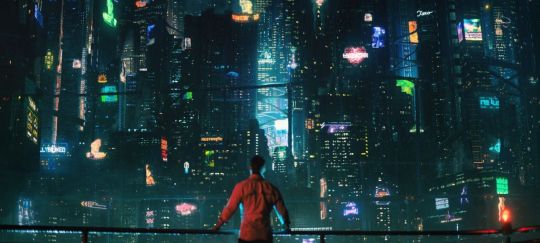
“Altered Carbon” is, at first blush, and even at second and third blush, a shameless, shameless rip off. Now, I haven’t read the books. For all I know, it is all in the books, and Netflix can’t take all the credit for my little conspiracy theory here. But by buying the rights to a little science fiction trilogy, this is what Netflix was able to accomplish:
--Rip off Blade Runner. Goddamn, does this show want to be Blade Runner. I am totally cool with that. Blade Runner has, to use the video game word, excellent “world-building.” It looks lived in, it has culture that isn’t just “bougie white people -- but in the future! with flying shit!” (well, I mean, it has that, and it wants to interrogate that in like a Communist way, but it ALSO has a whole racially diverse, class-diverse, tastes diverse, ground world), and there are complicated and believable politics and problems. It is the PERFECT setting for a noir -- dark, shitty, corrupt, complicated. Altered Carbon takes the perpetually nighttime neon hellscape of BR, and the flying car designs (spinners) to boot, and steals ‘em outright.
--Double Rip off of Blade Runner. Cast a white lead who looks good in a popped collar trench coat with a vaguely Harrison Ford-esque set jawline. Make him the hard boiled noir lead. Ok.
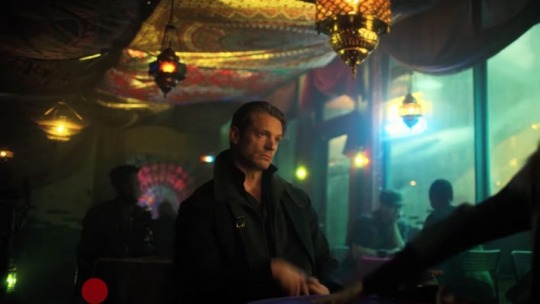
Not Harrison Ford, but close enough
--Rip off the plot twist of the highly problematic Ghost in the Shell American movie adaptation. This show does it much better, thank god. While the filmmakers of that one scrambled to explain their whitewashing as “its the point! it is examining HOW we replace asians with white people! get it!” (no. you suck.), in Altered Carbon, we spend a lot of time in the past with Kovacs original Asian sleeve (body), and when he is in his new white body in the future (against his will), he dislikes it and has no attachment to using the body apart from preserving it for someone else in the show who DOES care about that body. I mean, at times, he cuts into his impressive man-tits with a bowie knife. Gives no fucks about this body. The way sleeves are handled in this show is a-ok with me and doesn’t go the route of GitS level whitewashing, mainly, for me, because this is very much an “actor’s show” and GOD DAMN do they give actors of ALL races time to shine. People jump in and out of bodies like noone’s business, and how many shows give a bad ass Asian male actor the opportunity to play a sadistic Russian hitman? Few. (That actor had SO much fun and it was glorious to watch, for real.)

--Rip off Octavia Butler’s Earthseed / Parable of the Sower series. I mean, comon. In Kovacs’ past, the resistance leader has started a group who want to save humanity that live in a secluded stronghold in the forest, led by a leader who keeps a hand-written quasi-religious diary that defines the group’s spiritual ideology. The leader has baggage, dreams of flying. It is pretty damned shameless. Whatever. She’s a great character, and a woman of color (so was Butler’s protagonist).
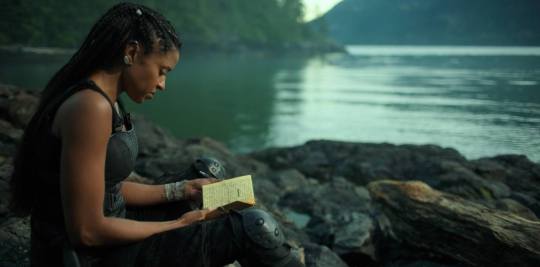
Quell Falconer, leader of the Envoys, echoing the Earthseed colony of Butler’s wonderful novels. Luckily, if Quell is a tribute, she does honor to the Parable series by being an excellent character.
--Rip off Metal Gear Solid. I really cannot explain this one without giving away ... like... fucking everything. But suffice it to say that, at least on a superficial level, the Praetorian soldiers helmets share much aesthetic similarity to the helmet of the Cyborg Ninja Gray Fox depicted below,
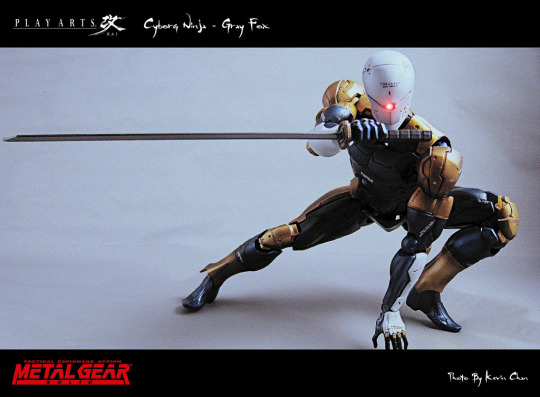

Altered Carbon’s “cyborg ninjas”, the elite Praetorian soldiers who serve the show’s big empire. As infantrymen, perhaps they bear more comparison to your protagonist in the Halo shooter games.
and speaking of the Cyborg Ninja, we even have a bloody hallway slaughter where a shadowy figure with an unexplained identity dispatches masses of people with nothing but a samurai sword and spinny tricks.

Altered Carbon’s Metal Gear ninja hallway massacre moment is appropriately acrobatic and badass.
Also....................... it definitely nods to Metal Gear’s sibling rivalry. Jesus H. Christ, sibling rivalry.
So that is to say, my conspiracy theory is that by buying the rights to one book, Netflix gets to rip off Blade Runner, Earthseed, Ghost in the Shell, and Metal Gear Solid, all in one, for really next to nothing (because Phillip K Dick is a GOLDMINE right now -- everyone, Amazon, whoever, has a Phillip K Dick show -- and buying Blade Runner would be hella expensive) and ... why?
Well, my answer to that is my little conspiracy theory. What is all of Hollywood obsessed with right now? The “Expanded Universe.” Star Wars arguably started this trend, in the 90s, but Disney, through Marvel, made it make money. DC wants badly to copy Marvel’s movie universe and make their shit interconnect but is basically failing. Fox, before Disney bought them, was making moves to make Alien / Prometheus into an extended universe. **Universal**, for gods sake, was trying to do this with that God Awful Tom Cruise Mummy movie. Everyone wants that Marvel money. And literally, Altered Carbon is SO FUCKING PERFECT for making an Expanded Universe. What is Disney’s little Star Wars problem? They can’t make a movie anymore without having a Carrie-Fisher-Died-Problem or a Everybody-Hates-The-New-Han-Solo problem. Netflix can make Altered Carbon Season 58 until the end of days and if there is ever “””””contract negotiation issues””””””” with the actors, to use the soap opera euphamism for “asking for too much money,” they just recast the actor in real life, “re-sleeve” the character’s body in the show, and movie on. Netflix is sitting on eternal wealth with this show: Blade Runner, with no “recasting Harrison Ford” problems. So,
When we ask ourselves a question like, “Why in Gods Name is a show about being able to casually discard a body and just jump in another one, no problem, not exploring Transgender and Transsexual issues?” My conspiracy answer is:
“Because you have to remake Blade Runner 1 to reign in the casuals into the larger Altered Carbon universe with that tried and true Hard Boiled White Guy Drama, and THEN we can make spin off products like Better Call Saul and Fear the Walking Dead to get that sweet, sweet Queer Money.”
So. That was a long explanation. But now I am ready to talk about what I really want to talk about: “The Margins of Altered Carbon that aren’t even barely in the show (yet): The Queer Possbility of Cross-Sleeving.”

Ava Elliot. Ava Elliot is cross-sleeved in a man’s body, for economic reasons. The biggest barrier to wearing any sleeve you want in the show is cost, which mimics the experience of real early 21st century transgendered individuals who both live in poverty and wish to have sex reassignment operations or hormones.
Altered Carbon takes a page from Star Wars in that the show’s backdrop is rich with an “implied world.” Key terms are dropped. Backstories are hinted at. Characters have “pasts” -- sometimes hundreds of years old pasts. One’s body is not static.
In this way, a culture around “stacks” and “sleeves” is implied by this vocabulary: “de-sleeved.” “Re-sleeving.” “Needle-casting” and “multi-casting.” “Double-sleeving.” “Real Death.” And then, the true subject of this blog entry: “Cross-sleeving.”
In the same way that “cancer” is not the same in a world where you can just buy a new body, or the state can “assign” you a body from its available inventory, “dysphoria” is not the same either. Someone who is uncomfortable in their body can try a new sleeve, even have a sleeve made to their specifications. In Queer theory, they have this reclaimed usage of the word “Monster” where the aspects of the non-normative body, say, an intersexed or transsexual body, are called “Monster” in the sense of being Other, but in a reclaimed tone where “Monster” does not have a negative connotation. In Altered Carbon, having the ability to be in any body you want does not mean that everyone chooses “perfect bodies.” The character Carnage, for example, chose a body whose jaw can unhinge and inflate at will, and who has deliberately uncanny eyeballs that look like an organic version of blackout colored contacts.
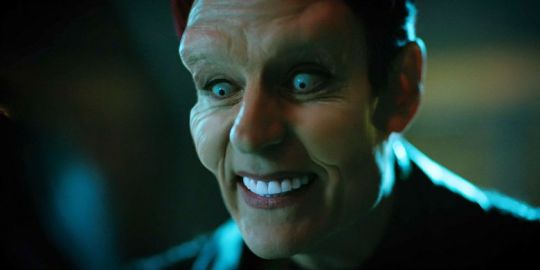

These aspects of “sleeving” hint at a rich universe of possibilities of the body that exist in this universe, even if they are not explored to a deep extent by mainly focusing on the primary murder mystery of Season 1. The Queer Body is marginalized by the season -- but the show hints at a VERY rich margin.
There are two instances of “Cross-Sleeving” shown directly in the show, or inhabiting a body of a different biological sex than the sleeve one was born in. One is the humorous example of the latina detective of the show stealing the body of a white supremacist to re-sleeve her abuela and take her home for El Dia de los Muertos.

This actor’s white supremacist sleeve, depicted above, was inhabited by a number of people on the show, and I must say, the actor was given an opportunity to show an INCREDIBLE range. He did an excellent job with every character he played, including the abuela. Many other actors are given this opportunity on the show, but I would not want to spoil them. The above depicted is a relatively minor character.
The abuela is entertaining to watch, but the cross-sleeving aspect was not really explored through her -- more the ethics of re-spinning up someone who had died, if the family has religious convictions against doing so. I suspect this was to give the religious angle full attention, as it is important in the show, but probably also to avoid risking alienating conservative viewers.
The other example of cross-sleeving explored in the show Is Ava Elliot. She previously could not be spun up due to expense, and is given the opportunity to do so in a cheap male body. Hence, she is cross-sleeved. This is an interesting way to put a cis-hetero individual in the dilemma of having gender dysphoria, and honestly, if it was done to prime conservative cis-hets for a further exploration of trans on the show, then it was brilliantly executed. The actor playing Ava does a good job affecting a feminine energy, portraying her discomfort in her skin, and also, focusing on the task at hand in the show, and not making a portrayal of feminine energy and conflict into “feminine hysterics.” I am happy that the show avoids this.
What the show has yet to portray is a character born in a body that they feel dysphoric in, going through the process of getting a new sleeve and learning to feel comfortable in the body they truly desire. I think that the current exploration of cross-sleeving, as a side plot, is a good introduction to the concept and probably an important excersise in empathy for the audience.
What will be interesting to see is what the show has to say about the Male Gaze through the narrative opportunity of Cross-Sleeving. It already is doing much to deconstruct narrative tropes through Double-Sleeving -- it is hard to say who is doing what, when any character who LOOKS like a certain actor, could actually be another character inhabiting that body.
What I hope the show will eventually do is this. Currently, the show affects the common Noir trope of sexualizing the female form, in a dark and fatale esque way. This is to be expected. Less common is that the film similarly objectifies the male body. In this sense, the Male Gaze is somewhat queered -- we definitely are directed to desire an idealized male body.

In this sense, there so far has been something of a “Bisexual Gaze” on the show. In a world where one can inhabit any body, or buy a perfected body, there are bodies that conform to unrealistic beauty standards. This is not out of place in the world of the show.
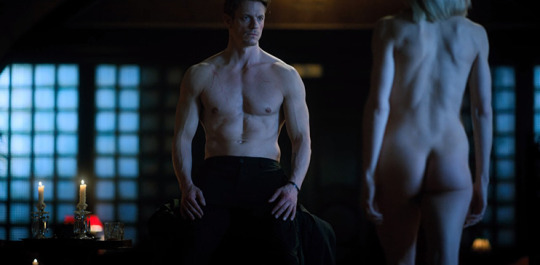
What I am interested in, is how does the Gaze handle bodies that are Queered, that are customized beyond the binary, that are Cross-Sleeved and have been depicted on the show by actors of different genders and sexes.
I am curious about how the Gaze is queered by looking upon a strong sexy masculine body, who then is later depicted, the same character, in a strong sexy feminine body. Perhaps, a character who is bi-cross-sleeved, double-sleeved and cross sleeved -- sleeved in two separate bodies, one male and one female! (God damn... that would be a strange sex scene too. This show probably would. There is a lot of sex in this show.)
The possibilities are there. It just needs to shake off the vestigial carcass of Gender Essentialism that comes with the show’s noir underpinnings.
Because the show is already critiquing the integrity of the Gaze (noone is what they seem! “Anyone” could be in there! The interpellative Hail of Althusser is constantly in flux, in motion, destabilized!) the show has a BEAUTIFUL opportunity to destabilize the rote Male desiring Gaze and to interpellate something very Queered or at least Bi in its audience.
It is an opportunity that the show has ignored so far. I hope very much that they capitalize on it. Comon. There is a place for queer desire in an Expanded Universe.
0 notes
Text
With his characteristic flourish, Wilde wittily deconstructs a dialectic of art, based on “usefulness.”
When I read this excerpt of Wilde’s, I am drawn to the similarity of “useless” / “useful” to the Marxist concept of “utility” or “use value” --
the deep, political truth that is hidden in Wilde’s flourish is that he defines art as being something that has no “use value”, can not be employed to productive utility by an exploitative, say, capitalist end;
in short, Wilde is saying that people who use art to do something, to convince, to profit, to instruct... are not making art at all. Their product is not art.
* * * *
In our overall conversation in this class about ideology and about art as a vehicle for ideology, I think this introduces an element that could be called something like “the ethics of the filmmaker.”
It is true of ideology that there is nothing outside of ideology -- so even if you want to produce art that does not serve ideology, that is purely use-less... you can’t. You will fail at this end.
So the “ethics of the filmmaker” becomes, knowing that my film will be ideological whether I like this or not, what is the film’s relationship to ideology?
Does it cook ideology into the image itself, and use the image as a didactic “backdoor”, like Spielberg and Lucas?
Does my film own its own ideology, wear it on its sleeve, and represent it abstractly and cartoonishly, the way that surrealist films and films in their tradition do? Films that I have encountered in this blog that could be said to do this include Belle du Jour, Ma Vie en Rose, Hannibal, and arguably even Gilda and Beau Travail. Even Chi Raq has some images that play around with this, like the great tank-phallus shot with Sam Jackson in it, but Spike Lee is nothing if not didactic in his style as a whole.
Does it nuke narrative all together and present the voices of its subjects without embellishment, like the documentary format of Venus Boyz?
These are different ethical and political positions on the “utility” of the film as a piece of art and as an unavoidable vehicle of ideology,
and the importance of a film that sees with different eyes than the Male Gaze is that such a film is what Wilde could call “useless” to the propogation of Patriarchy and Heteronormativity, a certain very pervasive strain of modern ideology that has sway in modern western culture, so a film with a Queer Gaze has something of a Wildean quality to it, for it is art that is for admiration, it is aesthetic, but it is “useless” and it does not “objectify” and “feminize” the way that the Male Gaze does, does not make the female form “useful” and productive / reproductive for the male audience.
A queer audience “admires (beautiful) useless things”... a radical political act
“We can forgive a man for making a useful thing as long as he does not admire it. The only excuse for making a useless thing is that one admires it intensely.
All art is quite useless.”
- Oscar Wilde, Preface to The Picture of Dorian Gray
1 note
·
View note
Text
“We can forgive a man for making a useful thing as long as he does not admire it. The only excuse for making a useless thing is that one admires it intensely.
All art is quite useless.”
- Oscar Wilde, Preface to The Picture of Dorian Gray
1 note
·
View note
Text
TABLE OF CONTENTS MASTER POST FOR MCS 143F, PART II, Entries 9 through 14 and thesis
.
>Working thesis:
>Current Version: https://territorializethis.tumblr.com/post/170918163301/amorphous-beginning-of-a-thesis-condensed
>Brainstorming that resulted in current version: https://territorializethis.tumblr.com/post/170917869461/an-amorphous-beginning-of-a-thesis
.
>Table of Contents Master Post Part 1 link, covering Entries 1-8 (week 1 entry 1, weeks 2-4 entries 1 and 2, end week 5 entry 1 of 2):
https://territorializethis.tumblr.com/post/170912619761/table-of-contents-masterpost-for-mcs-143f
.
>WEEK 5 ENTRY 2 of 2, Surrealism reconsidered, or looking for a counter-narrative to Belle du Jour in NBC’s Hannibal.
https://territorializethis.tumblr.com/post/171241358566/week-5-entry-2-of-2-surrealism-reconsidered
.
>WEEK 6 ENTRY 1 of 2, Body Narrative, or Beau Travail as a counterpoint to Spielbergian Didacticism
https://territorializethis.tumblr.com/post/171248372881/week-6-entry-1-of-2-body-narrative-in-a-lot-of
.
>WEEK 6 ENTRY 2 of 2, The Queering of Billy Budd’s Repressed Erotics in Beau Travail
https://territorializethis.tumblr.com/post/171249388706/week-6-entry-2-of-2-the-queering-of-billy
.
> WEEK 7 ENTRY 1 of 2, Representation, and representation of nonbinary bodies’ queering of the Gaze (Venus Boyz)
https://territorializethis.tumblr.com/post/171293006246/week-7-entry-1-of-2-representation-and
.
>WEEK 7 ENTRY 2 of 2, “Male” as Non-exclusive performance in Venus Boyz
https://territorializethis.tumblr.com/post/171294073466/week-7-entry-2-of-2-male-as-non-exclusive
.
>WEEK 8 ENTRY 1 of 2, Gender Construction, Cronenberg’d
https://territorializethis.tumblr.com/post/171316197366/week-8-entry-1-of-2-gender-construction
0 notes
Text
WEEK 8 ENTRY 1 of 2: Gender Construction, Cronenberg’d
It is hard to see M Butterfly without beginning from the fact that it is a Cronenberg movie, even if it is not at all, superficially, a typical example. Cronenberg’s oeuvre works almost as a whole, as a “body” (heh) of works in conversation with each other: what is monstrous? What in the human is horrific? What monstrosity of the human psyche is the stuff of horror when it is actualized into a physical body?
The transformation of the body into monstrosity is so much a part and parcel of what Cronenberg is that Rick and Morty verb’d it and noun’d it -- one famous episode features people getting “Cronenberg’d”, after which they are “Cronenbergs.”

Cronenberg Rick from Rick and Morty, Adult Swim cartoon television show by Dan Harmon and Justin Roiland
The things that are made monstrous in Cronenberg are often this: hubris. Ambition.

Jeff Goldblum in The Fly (1986).
The connection between a mother and her child -- and the extreme lengths a mother will go to to connect with her blood -- are made monstrous in the horrifying The Brood.
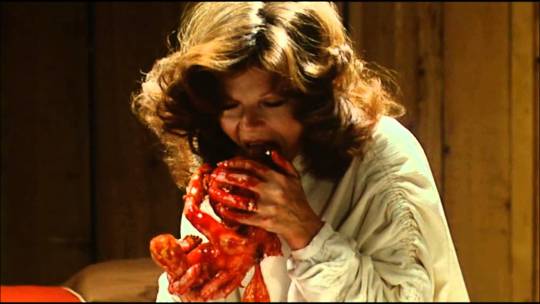
Cronenberg’s The Brood (1979).
The obsession of the writer, losing himself in worlds of the imaginary, is made monstrous in Naked Lunch.

Cronenberg’s adaptation of the notoriously “unfilmable” Naked Lunch (1991) by beat author William S. Burroughs.
Then there’s Videodrome. Videodrome takes the relationship of the audience and the screen and the Gaze and is just like, Ima fuck your shit right up, son.
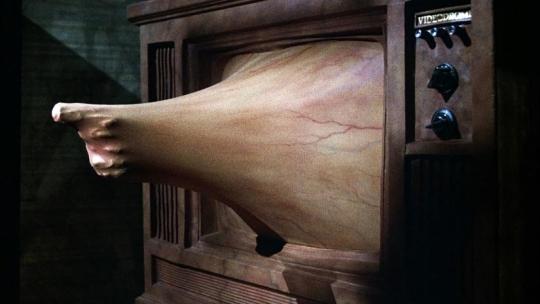
Cronenberg’s Videodrome (1983).
However, the closest analogue to what M. Butterfly does -- and M. Butterfly both is and isn’t an anomaly in Cronenberg’s filmography -- is probably his other film starring the wonderful Jeremy Irons, the film about twin gynocologists, Dead Ringers (1988).


Dead Ringers begins with women born with “abnormally” shaped genetalia, and a pair of gynocologists who are interested in designing surgical implements for working with these genetalia. The fascinating move that the film makes is it seems to fuck with the expectations of a Cronenberg viewer, depending on what “monster” means to them -- perhaps, the women could be seen as “monsters,” for their physical difference. But no. It is firmly the madness of wanting to enter flesh with technology that is the “Cronenbergs” in this film... and the implements that the brother who “loses it” ends up designing, are indeed horrific, with clawlike shapes and hooks. The normalizing instinct, the homogenizing instinct, the obsession of men with entering the body of woman and transforming her into something that suits his idea of perfection... this is the “Cronenberg” of Dead Ringers.
* * * *
Of his 21 films, only 4 of them can really be considered “normal movies.” (lol). That is to say, nobody really gets “Cronenberg’d” up in them. These are A Dangerous Method, Eastern Promises, and A History of Violence (three films made back to back, and representing a sort of “period” for Cronenberg... each are excellent films, by the way. Cronenberg does “convention” better than “conventional” directors do “convention,” if he wants to.) and then M. Butterfly. In the case of each of these films, however, it is productive to read them in concert with his “monstrosity” and “transformation” movies. What is “monstrous” in these films? Who is “becoming”? What are they “becoming?”


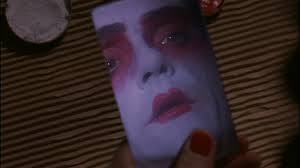
I think, again, that Dead Ringers provides the key. The women patients of the twins are physically different, Othered -- the male Chinese opera singer of Butterfly is also physically different, Othered, and Irons’ “adventurous imperialist” becomes Othered in the film’s centerpiece transformation, analagous to transformations in other Cronenberg films -- but it is those who would taxonomize Dead Ringers’ women who are monstrous, not the women themselves; it is the Othering instinct in the gynocologist that is the “Cronenberg,” physically manifest in his horrific technological inventions. Similarly, I would say that what is monstrous in M. Butterfly is heteronormativity, is racial priveleging, is the homophobic instinct in culture that looks upon an affair between a man and a man or a white and a Chinese as an issue, as worth destroying lives and reputations over, not the relationship itself...
...and in this, Irons’ character’s transformation into the Madame Butterfly in the film is a very unique transformation in terms of Cronenberg’s filmography, because it is a transformation that is a redemptive transformation, not one that is degraded or perverted or signalling a cultural depravity...
Irons begins the film as an example of a depraved being, saying casually racist things like “you know the Chinese don’t like Madame Butterfly because the white man gets the girl? Sour grapes.”, but by the end is willing to subvert the observation that the opera singer makes at the beginning of the film: “if a white woman sacrificed herself for a small Japanese man, you would think her mad,” by becoming the “mad woman,” by embodying that sacrifice and embodying the woman sacrificing for love to show his beloved Opera singer that he is worth a kind of love represented by the opera Madame Butterfly. His transformation is into something less depraved... into the Other in drag that subverts the monstrosity of the Male Gaze, a Gaze that surrounds him in his transformation at the end, in the form of the male prisoners towering above him, representing not just the Male Gaze but the Male Gaze that was bad enough to be even too depraved for the depraved heteronormative outside.

The “monster”, the “Cronenberg” of M. Butterfly -- the Male Gaze, and specifically a western, imperialst Male Gaze.
“You know me, yes?” Irons says. They laugh and jeer.
The Hail, of Althusser. Irons Hails himself. They respond by interpellating him as a ridiculous subject, one who would love another man. Othered.
This parallels when Irons laughed at his male love’s naked body just a scene earlier, still, even then, not having transformed into something “better than.” Irons’ gaze upon his love was the Male Gaze, and he says that he can’t believe he threw it away for “just a man.” He is still the racist, homophobic piece of shit he began the movie as, he is still just like the prison audience.
Then, he sheds his Cronenberg. In the words of Brundle’s Fly, the Opera Singer helped him to “be more human.”

1 note
·
View note
Text
Aw fuck no
why even tumbl if not for spicy sexy gifs
fyi if you’re suddenly missing people on your dash
Account > Settings > Filtering > click the Safe Mode button off

cause tumblr just turned this on for everybody
please note, on an iPhone you’re actually going to need to leave the app to modify this under your phone settings
iOS:
Leave the Tumblr app, go to the main Settings app on your device.
Find Tumblr in the apps list
Scroll down to the very bottom to find the Safe Mode settings
Android:
Go to settings: Tap the person icon in the tab bar, then the gear icon in the top right, then “General settings.”
Tap “Filtering” to find the Safe Mode switch
2K notes
·
View notes
Text
Review of Professor Marston and the Wonder Woman
Healthy poly representation Toxic behavior used well and addressed well Non shameful look at BDSM Non male centric focus Sex scenes were tasteful and not from male gaze Women were not competitive Ten languages available on single Blue-ray Twenty-five subtitle options Excellent film, highly recommended.
Okay, now for the long version.
Keep reading
530 notes
·
View notes
Photo
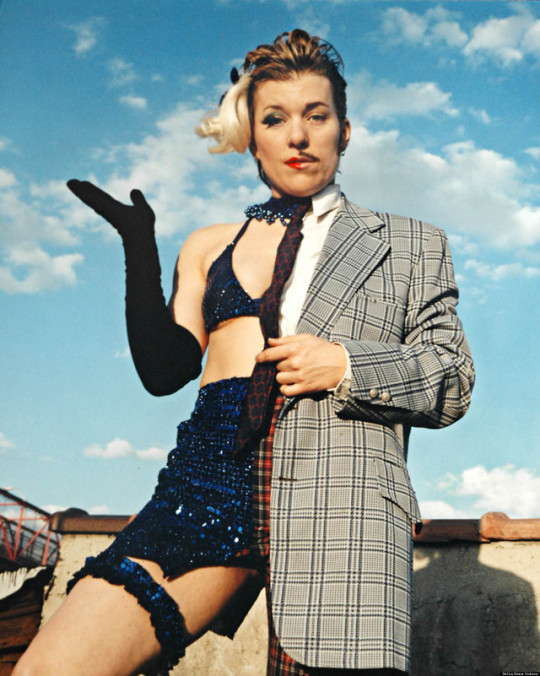
Photo credit: Del La Grace Volcano Pictured: Mo Fischer
0 notes
Text
WEEK 7 ENTRY 2 of 2: “Male” as (Non-exclusive) Performance
youtube
“If that’s the case (that even a ‘woman who lives next door’ like me can be this ‘macho’), then anybody can do it, and so much for masculinity being sacred.” - Diane Torr in Venus Boyz (end of clip above)
The critique of “gender essentialism” that is baked into even the day to day lives of the Drag Kings portrayed in Venus Boyz is well articulated in Diane Torr’s quote above -- there is no reason that one needs a penis to perform “masculine.” The other thing that Torr illustrates well is the little things that are socialized, which she has an awareness of with impressive attention to detail -- ways of breathing, patterns of thinking. She performs feminine with equal attention to detail -- she has awareness of both sides of the binary as performance, and of the performances’ difference. In the following clip, Torr describes gendered ways of “being present” and walking, and even ways of “looking out” at the world and “placing the conciousness on the eye”:
youtube
The process of being socialized with one’s “proper” gender identity at a young age make one’s cis-gender a very “natural” performance for cisgendered individuals, but this does not mean that one cannot, through interpersonal study and self-awareness, perform another gender, and perform it “well”, if there is such a thing as doing gender “right” (there isnt).


The photography project done by Del LaGrace Volcano and Mo Fischer in Venus Boyz was a wonderful depiction of the play of gendered signifiers. The same body, Fischer’s -- one she self-describes as “aggressively female,” but one comfortable enough in male drag for her to speak of “losing” herself in male identities -- presenting female clothing and grooming signifiers on one side, male ones on the other. Gender essentialism would look for ways that one of these could not “pass”, that one of these is “only” performance, that one of these is the “correct” one. But Fischer inhabits both as it suits her, and with the presence of both signifiers, challenges that picking a definitive “side” in the binary is compulsory.
* * * * *
youtube
Venus Boyz showcases both sides of a performance, and in that sense it is useful as a lens for examining the cinema apparatus. The subject on the stage, Bridge Markland, is a King, and the audience is largely comprised of other Kings, other individuals experimenting with gender and with performance.
Do they bring to the audience of such a stage a Male Gaze -- do they objectify their fellows? Do they “play” the Male Gaze of an objectifying audience, the way for some machisimo is play?
Or is there something different here? A queered Gaze that looks at the gendered performance as not lesser and not more than one’s own... simply either in the spotlight or watching it?
I don’t have an answer to that question, but I feel it is worth asking.
0 notes
Video
tumblr
WEEK 7 ENTRY 1 of 2: Representation, and representation of nonbinary bodies’ queering of the Gaze
The segment of Venus Boyz posted above is beautiful to me for a lot of reasons -- but an important one is that this is not a presentation of “human” that gets seen alot on the screen, bigscreen or smallscreen. Here you have a person who neither presents really male or female wholly, and in some ways presents both, telling of their cares and their family and their concerns. You see Storme Webber presenting their art -- a song, something like the blues tradition, something like spoken-word traditions, something like the oral traditions of native peoples. All uniquely “them.” You have insight from someone who is “intersectionally Othered”, who is marginalized on levels of race, class, gender, parentage, and in varying and crossing ways for each.
Webber is given this platform to speak and to sing in a documentary format, under the category of “documentary about women and trans men who perform male drag.” The question I was having as I was watching this individual share their story, however, was, “Why is there not fiction narratives built around individuals like this?” I was spellbound by this beautiful person -- by their story, by their voice, by their way of holding and presenting themselves. Why is it that we write characters who are rigidly male, rigidly female, perhaps gay or lesbian or perhaps in some way critiquing roles, but we do not typically write characters who are more “radically nonbinary” like this person?
Where is the filmic superhero who was raised by a gay man and a lesbian?
Where is the detective mystery that involves a nonbinary protagonist?
Where is the family drama about a life like the one described here in this short segment?
And following from these questions --
How does the Male Gaze handle an individual like Webber, except.... to not? It does not objectify their body in the way of a sexualized female body, and it does not approach them as a point of identification for male power ... a wielder of the gaze. Would it seek to fetishize their nonbinary body, as different, but perhaps an “exotic object?” Perhaps. Perhaps this is the movement left for the Male Gaze. But I submit: that this is not the only avenue for representation on the screen. If in a larger sense I theorize a cinematic gaze that is not the Male Gaze, then perhaps the nonbinary body is a cinematic subject long excluded by the traditional cinema apparatus that compliments another kind of Gaze, that instead of being kneeled down prostrate as object, gazes back at the camera and the audience on an equal footing. Mulvey theorized that whatever your gender, when you slip on the cinematic gaze, you are now Male, Male Gazing. Well perhaps nonbinary subjects, communicating through the lens and hailing the audience, cast a stone into the pond of the unknown audience that they cannot see, and interpellate their audience if successful as an audience who respects them and who they respect.
I wish I saw subjects like Storme Webber and the others of Venus Boyz represented more often on the screen.
0 notes
Text
youtube
A dissection and discussion about how media dictates how queer identities can be represented in movies/television and how it becomes detrimental because of it’s “othering” of bodies.
1 note
·
View note
Video
youtube
WEEK 6, ENTRY 2 of 2 - The Queering of Billy Budd’s Repressed Visual Erotics
Beau Travail is an incredibly loose adaptation of Billy Budd. It retains: a visual erotics of the male body, formal military biopolitical body discipline as a backdrop, a climax event of a vindictive action of desire and envy that destroys self and other. However, where it chooses to diverge is a fruitful place to begin a reading.
Above is the ending of Beau Travail. It is already a departure, because our man-of-war has survived the climax. Indeed, Billy Budd is not killed of a disciplinary act of the Repressive State Apparatus just as he does not impulsively lash out in response to the man-of-war’s accusation in lieu of words he does not have. Instead, the surviving man-of-war is living with the guilt that his act of jealousy directly killed Billy Budd, instead of trying to destroy the younger man’s life using the Repressive State as a weapon. The man-of-war lives with his guilt, just as Billy is carried out of the salt-desert by nomads, perhaps echoing Billy’s continued life as symbol at the end of the novel.
Giving credence to the symbolic read is the strange conclusion of the man-of-war’s ““““suicide”““““. He makes his bed crisply, showing the vestiges of the military cycles of habit, perhaps implying that the embodied-time that we have followed throughout the film is now all that the man-of-war has.... he does not have the legion, but he cannot escape the mark it has left on his life. Because he has lost the legion which is everything for him, he cradles his gun, perhaps ready to end his own life.
Then, in the disco club that begins the movie, though all alone, where in the opening of the film there was a community moving together, Galoup begins an interpretive dance. A very GOOD interpretive dance.
In contrast to, say, the self-serious realism of Hollywood, this film seems to take up a Judith Butler conclusion -- this is performance. All of life is performance. I am going to put out a performance that *knows* it is performance, instead of one that masquerades as what Barthes calls a “degraded spectacle” -- something that does not acknowledge its own unreality. The man-of-war points a desirous Male Gaze at Billy Budd that leads to envy and leads to sacrifice ... the envy that becomes his guilt is now his life, is now the truth of his character. So what does he do? He performs. We all perform our truth, or perhaps a fiction that we would prefer to put out. Denis Lavant, instead of portraying an embodied self-serious, realist truth (Daniel Day’ing it), dances his truth fabulous as fuck and the movie ends. This is a different way of queering the Gaze than Hannibal, for example, performs. Hannibal queers the Gaze by making its uncomfortable aspects obvious, overt, all the more uncomfortable. La Ley del Deseo also does this. Beau Travail queers the Gaze by making it banal, removing the “degraded” from the “spectacle”, removing the “didactic” from the “narrative,” and when all that is left is the male body and his story... dancing. Nice.

0 notes
Text
WEEK 6, ENTRY 1 of 2 -- Body Narrative
In a lot of conventional Hollywood media, the way the trafficing of the visual works is like this: it creeps in the back door while the narrative is working on your logical mind. What I am thinking of while I say this is pretty much anything Lucas or Spielberg.

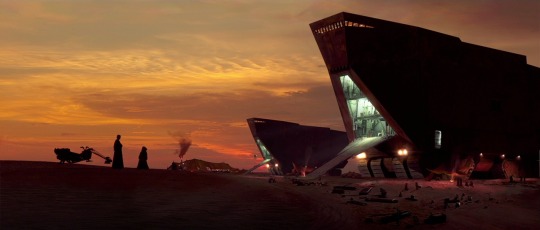
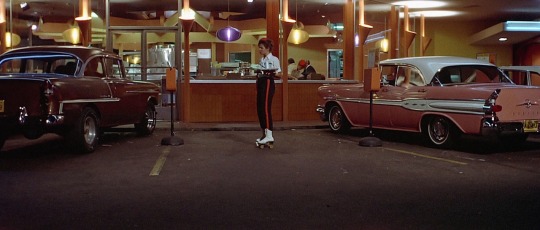
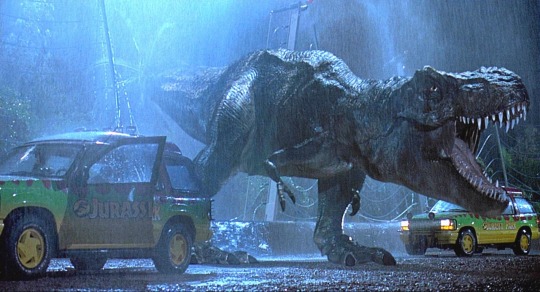
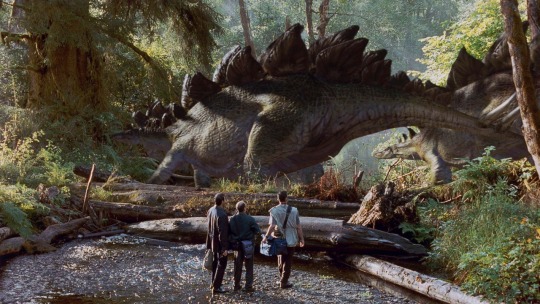
In their films and the many, many mainstream films like them, dialogue and narrative-event progress the plot in a linear buildup which you process in Hansel and Gretel breadcrumbs at very regular intervals, between which breadcrumbs there is a kaliedoscope of almost incidental visual spectacle -- over the top, wide angled, painterly in scope and composition, but incidental in the sense that a long and dramatic set piece of many minutes might only advance one simple plot point, like "the dino escapes" or "Anakin looks for the sand people" -- almost incidental visual spectacle gives us tone, stakes, even a sort of visual ethics and ethos. You know who the good and bad guys are in these movies because of how they are LIT, or what color pallette everything appears in. The "incidental" spectacle is everything in this school of film (it is not really incidental at all, the tightly written narrative progression just handles it as such), where the plot seems only an excuse to drive us from painting to painting. The incidental spectacle becomes the more subliminal and effecient vehicle for ideology, the “showing” not “telling” that they tell you to do in English 100 for a descriptive essay -- Lucas's romantic shots of Farmboys watching sunsets in the desert amount to like a visual argument for a libertarian fantasy of free will in a lawless desert in a lawless galaxy.
Beau Travail uses image, plot, and the relationship between them very differently than that than usual Hollywood romantic didacticism. Rather than there being a sort of separation between visual and plot, where the two deliver two different messages via two different communicational avenues, in Beau Travail, it seems that the visual IS the plot. Though there is dialogue in it, and some sense of the passage of time, time is not predicated on the logic of the narrative's demands-- where like, it is the sunset of Anakin's black heart, so lets make it sunset to add high drama to Anakin's descent into the dark side. Just as the men move through their training routines and have a disciplined move through the cycle of days and nights, so Beau Travail cycles through the movements of the bodies on the screen -- to an audience trained to be swept up in a narrative like the Peter Pan ride at Disneyland, led in a sequence of linear progressions that build to a climax, Beau Travail can often seem aimless, a purposeless succession of flexing bodies.

However, if film is a communicative medium, it is simply a different type of communication-- the Spielbergian way is to be visually didactic, to instruct the audience of a clear morality like the eye of God that is shared to the audience while the characters muddle through their flawed mortal pathos, while Beau Travaille inserts us into the experience of the characters, not above and wiser and "better morally informed" than them but attuned to the cyclic movements that is the time of the soldier. If in Spielberg, the eye of the camera and the eye of the film is the instructional Eye of God, Eye of the Father, Eye of the Superego, instructing us how to see, then here, it is the Eye of the Comrade, the Eye of the Brother. Beau Travail is not above us, it is *with* us.
youtube
Claire Denis tries to use the descriptive potential of the camera to mirror some of the descriptive accomplishments of Melville’s Billy Budd. With one simple, repeated moving image, the ordered, disciplined chaos of the clashing bodies of soldiers in a grapple-drill, Denis communicates some of what Melville does of the discipline of inhabiting the body of a sailor, of the almost “instinct” like response that Melville describes of following an order. Typically, this is the kind of meaning that films excise as “unfilmable.” Perhaps it is better to say not that it is “unfilmable,” but that our minds are to preoccupied with “recieving moral instruction” to pay attention to the nuance of the message of a body.
At the end of the above clip, we see the gaze of their superior officer, matching the figure of Melville’s Captain Verre, watching them. We are not privy to his thoughts. We do not, unlike in Hollywood, recieve explicit instruction as to what authority sees in the clashing bodies beneath. We know simply that he watches. It is a break in identification with the authoritative gaze. And indeed, it is as if he looks directly at us.
There is a 5 minute stretch at the core of the film, which in my copy (total length 1:29:10), begins at the 00:39:46 mark with the Captain figure and the man-of-arms accuser figure playing a chess game together while the man-of-arms plays with a hand rolled cigarette. This five minutes -- which moves between the man-of-arms playing chess (in which the Captain tells him that “backstabbing isn’t in the legion’s honor code”), Billy Budd’s figure playing a second game of chess, Galoup (the man-of-arms) moving about as a civilian having survived the events of the Billy Budd narrative (?!) and expressing regret at “having been the man he was,” and finally, Galoup analyzing the images of his time with the legion and noting that they are gone.
youtube
I believe that this five minute stretch unlocks the whole film -- it could be presented by itself. The soldier who circles the convoy truck of soldiers -- appraises each of their faces, bodies, dress, presentation, and then waves them on -- in some ways, represents a composite of us, and of the view of the Ideological State Apparatus or society, which is to say, also us... he takes in the image of the soldiers for a moment, reads the message of their bodies, and then, having “interpellated them as subjects,” waves them on.
1 note
·
View note
Text
Replace "human child laughter" with "any kind of gaze but the Male Gaze" and "screams" with Male Gaze", and replace "Monsters Inc" with "Any Movie", and viola, you have my thesis
me watching monsters inc as a kid: how did it take so long for anyone to figure out that human child laughter not only produced energy like screams, but was more effective, and that children aren’t actually dangerous at all?
me watching monsters inc now: monsters incorporated, a multi-billion dollar corporate giant, stood to make extra profits off a scream shortage because low supply with high demand makes it possible to charge a fortune for a necessary commodity and everyone has no choice but to pay the high prices because they can’t go without electricity. Therefore Monsters Inc, as well as any other major powers that may have existed at the start of the era of using scream energy, fabricated the idea that only screams could generate sustainable energy sources in order to create artificial scarcity, because laugh energy was far easier to obtain and far more efficient, and therefore stood to lower the value of energy due to surplus. They also fabricated the idea that human children were toxic, in order to a) make other monsters too afraid to go near them to do research and possibly discover the secret of laugh energy, and b) to make monsters so afraid of going near them that there is a shortage of scarers, making it harder for rival companies to rise up and create competition. Even in the monster world, capitalism is based on lies, greed and cruelty, and even monster companies have no qualms about using and abusing children to maximize profits.
382K notes
·
View notes

